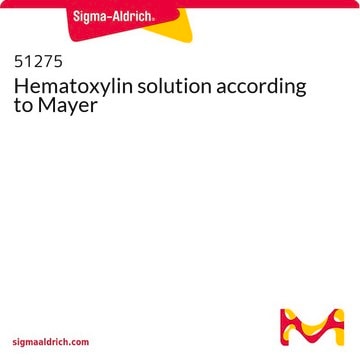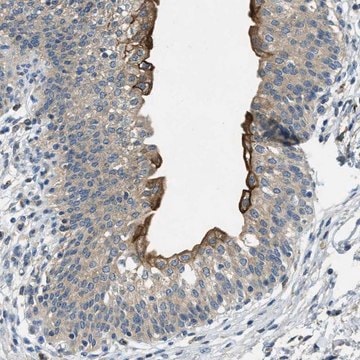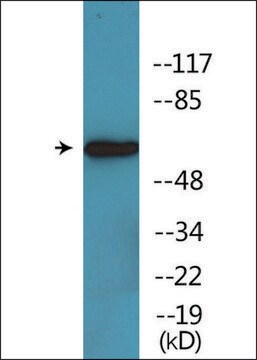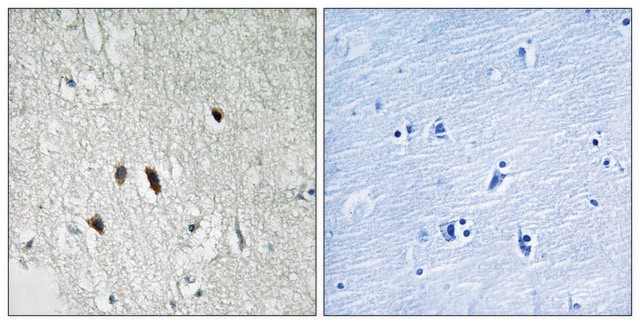おすすめの製品
由来生物
mouse
結合体
unconjugated
抗体製品の状態
purified immunoglobulin
抗体製品タイプ
primary antibodies
クローン
6F7, monoclonal
形状
buffered aqueous solution
分子量
antigen ~38.21 kDa
化学種の反応性
mouse, human, rat
テクニック
capture ELISA: suitable
immunohistochemistry (formalin-fixed, paraffin-embedded sections): suitable
indirect ELISA: suitable
western blot: 1-5 μg/mL
アイソタイプ
IgG2aκ
NCBIアクセッション番号
UniProtアクセッション番号
輸送温度
dry ice
保管温度
−20°C
ターゲットの翻訳後修飾
unmodified
遺伝子情報
human ... RIPK2(8767)
関連するカテゴリー
詳細
Receptor interacting serine/threonine kinase 2 (RIPK2) belongs to the RIP kinase family. The protein contains a caspase activation and recruitment domain (CARD) at the C-terminal, N-terminal kinase domain, and a bridging intermediate domain. The gene is mapped to human chromosome 8q21.3.
This gene encodes a member of the receptor-interacting protein (RIP) family of serine/threonine protein kinases. The encoded protein contains a C-terminal caspase activation and recruitment domain (CARD), and is a component of signaling complexes in both the innate and adaptive immune pathways. It is a potent activator of NF-kappaB and inducer of apoptosis in response to various stimuli. (provided by RefSeq)
免疫原
RIPK2 (AAH04553, 431 a.a. ~ 540 a.a) partial recombinant protein with GST tag. MW of the GST tag alone is 26 KDa.
Sequence
LQPGIAQQWIQSKREDIVNQMTEACLNQSLDALLSRDLIMKEDYELVSTKPTRTSKVRQLLDTTDIQGEEFAKVIVQKLKDNKQMGLQPYPEILVVSRSPSLNLLQNKSM
Sequence
LQPGIAQQWIQSKREDIVNQMTEACLNQSLDALLSRDLIMKEDYELVSTKPTRTSKVRQLLDTTDIQGEEFAKVIVQKLKDNKQMGLQPYPEILVVSRSPSLNLLQNKSM
アプリケーション
Monoclonal Anti-RIPK2, (C-terminal) antibody produced in mouse has been used in immunoblotting (1:500).
生物化学的/生理学的作用
Receptor interacting serine/threonine kinase 2 (RIPK2) is a key regulator of the immune and inflammatory pathways. It is a potent activator of nuclear factor (NF)-κB via nucleotide-binding and oligomerization domain (NOD) receptor. RIPK2 is associated with the progression and aggressiveness, tumor size, metastasis, and overall stagging in various types of cancers. Overexpression of RIPK2 is observed in the head and neck squamous cell carcinoma (HNSCC), gastric cancer, colorectal cancer (CRC), and lethal prostate cancers. It is found to induce cell proliferation and inhibit apoptosis in glioma and breast cancer. RIPK2 polymorphism is also associated with the onset of bladder cancer.
物理的形状
無色透明のPBS溶液、pH 7.4
免責事項
Unless otherwise stated in our catalog or other company documentation accompanying the product(s), our products are intended for research use only and are not to be used for any other purpose, which includes but is not limited to, unauthorized commercial uses, in vitro diagnostic uses, ex vivo or in vivo therapeutic uses or any type of consumption or application to humans or animals.
Not finding the right product?
Try our 製品選択ツール.
保管分類コード
10 - Combustible liquids
WGK
WGK 1
引火点(°F)
Not applicable
引火点(℃)
Not applicable
試験成績書(COA)
製品のロット番号・バッチ番号を入力して、試験成績書(COA) を検索できます。ロット番号・バッチ番号は、製品ラベルに「Lot」または「Batch」に続いて記載されています。
Vivek Misra
Annals of neurosciences, 21(2), 69-73 (2014-09-11)
Available research data in Autism suggests the role of a network of brain areas, often known as the 'social brain'. Recent studies highlight the role of genetic mutations as underlying patho-mechanism in Autism. This mini review, discusses the basic concepts
Rola F Jaafar et al.
Medicina (Kaunas, Lithuania), 57(7) (2021-08-07)
Background and objectives: Receptor-interacting serine/threonine-protein kinase-2 (RIPK2) is an important mediator in different pathways in the immune and inflammatory response system. RIPK2 was also shown to play different roles in different cancer types; however, in colorectal cancer (CRC), its role
Ueli Nachbur et al.
Nature communications, 6, 6442-6442 (2015-03-18)
Intracellular nucleotide binding and oligomerization domain (NOD) receptors recognize antigens including bacterial peptidoglycans and initiate immune responses by triggering the production of pro-inflammatory cytokines through activating NF-κB and MAP kinases. Receptor interacting protein kinase 2 (RIPK2) is critical for NOD-mediated
Yongyu Chen et al.
Theranostics, 10(1), 323-339 (2020-01-07)
Aims: We aimed to measure the abundance of Fusobacterium nucleatum (F. nucleatum) in colorectal cancer (CRC) tissues from patients and to uncover the function of this bacterium in colorectal tumor metastasis. Methods: We collected metastatic and non-metastatic CRC tissues to
Lucien P Garo et al.
Nature communications, 12(1), 2419-2419 (2021-04-25)
Chronic inflammation can drive tumor development. Here, we have identified microRNA-146a (miR-146a) as a major negative regulator of colonic inflammation and associated tumorigenesis by modulating IL-17 responses. MiR-146a-deficient mice are susceptible to both colitis-associated and sporadic colorectal cancer (CRC), presenting
ライフサイエンス、有機合成、材料科学、クロマトグラフィー、分析など、あらゆる分野の研究に経験のあるメンバーがおります。.
製品に関するお問い合わせはこちら(テクニカルサービス)







